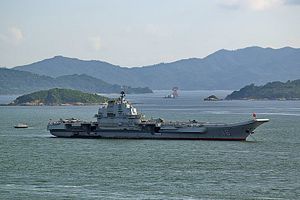Abraham Ait has suggested that the U.S. Navy should begin to think about China’s new amphibs along the same terms that it thinks about its own amphibious ships; as potential light aircraft carriers. In particular, he raises the question of whether China could consider developing or acquiring a VSTOL fighter aircraft, perhaps founded on the cancelled Soviet Yak-141 supersonic fighter of the 1980s. The Yak-141 famously gave its vertical lift system to the F-35B before expiring, and the F-35B is currently the only vertical and/or short take-off and landing (VSTOL) fighter in production anywhere in the world.
So could it be done? Could China be considering something like the Yak-141 for its big amphibs, in order to match the assault carriers of the U.S. Navy?
The question is extremely complicated. U.S. interest in VSTOL fighter aircraft developed through a complex bureaucratic process that involved the Navy, the Marine Corps, a series of legacy vessels intended for alternative purposes, and most recently a gigantic procurement project involving three aviation services and heavy Pentagon pressure. It’s worth revisiting how the most lethal elements of the U.S. “Gator Navy” came to be.
The Harrier, the most successful VSTOL fighter in history, was not developed as a carrier aircraft. Rather, it was one of a variety of projects designed to offset what NATO expected to be a series of tactical nuclear attacks against its airbases in the early stages of a general war. The Harrier and its less successful brethren could continue to fly and fight from improvised airfields even after this initial onslaught. Indeed, West Germany invested more than anyone in VSTOL capabilities because of these concerns.
VSTOL carrier aircraft were an afterthought. The United States, the United Kingdom, and France all possessed large-deck carriers capable of launching CATOBAR fighters; they didn’t initially see a need to supplement these with limited VSTOL fighters. But the British carrier force deteriorated, and the United States began to consider leveraging the large, flat decks of its existing fleet of amphibious assault ships. The U.S. Navy also briefly considered “Sea Control Ships,” very small carriers intended for convoy escort. And so both the U.S. and the U.K. adopted the Harrier, which also eventually populated the decks of small carriers in other navies. That innovation became both an asset and an institutional need, eventually leading to the F-35B.
Soviet VSTOL development was more straightforward; the Soviets developed the Yak-38 to fly from light carriers before it ever possessed heavy carriers, and developed the Yak-141 to replace and enhance that capability. Both types represented a bridge to the USSR’s conventional carrier fleet, as well as a way to enhance existing platforms.
But why would anyone want to reconstitute the Yak-141 line? To be sure, the fighter was supersonic and could take off from small carriers. These are not small virtues; to date, only the F-35B can achieve both, and the United States strictly limits the availability of that aircraft. But its appeal ends there; it never entered extensive testing, it lacks the capabilities of modern fighters with respect to speed and maneuverability, and it lacks any stealth characteristics. Without extensive redevelopment, the Yak-141 would be a weak air superiority platform with no other major virtues.
But heavy investment in an entirely new fighter with a very limited production run, but with all of the characteristics of a modern fighter, seems unlikely. Russia simply doesn’t need very many supersonic VSTOL fighters; it may not need any at all. China could use a few more, but if it wants medium-large platforms to launch limited-capability fighters from, it can simply build more Type 001 aircraft carriers. China’s amphibious fleet isn’t a legacy force; the PLAN is building it alongside the new carrier force, and seems to want the ships on their amphibious merits.
Moreover, the F-35B would not exist in its modern form without the F-35A and the F-35C. The United States would not have invested in the development of an entirely new VSTOL stealth fighter under the expectation that it would buy only a couple hundred units. And unless China or Russia plan to buy more than a couple hundred units, it’s difficult to imagine a new VSTOL stealth fighter finding its way onto the decks of these ships.

































